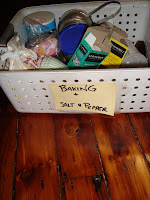Every time I do something in a skillet, I want to tell you all this side light information, and I think I'm getting redundant. Redundancy is inefficient. Hello separate post to link to in the future, welcome to the past. Unless I link this for past posts to which it applies, which in that case, welcome to the future.
Yes. Skillet stuff.
Exhibits that follow:
A. Preheating skillet
B. Oiling skillet
C. Why bother?
D. Why I like Olive Oil
E. Technique notes
F. That nifty airflip technique.
A.) Preheating skillets is a step I often try to skimp on and then I regret. You'll benefit by knowing what this step is doing for you.
--Preheat before oiling skillet (If you are using an oil with a very high smoking temperature you can cheat here a bit)
--A properly heated skillet will immediately sizzle a drop of water, which you can drip from your fingers.
B.) Once skillet is properly heated as above, it is time to properly oil it.
--I do an oil prep first even if the recipe calls for butter in the pan, it reduces scorching and burned butter.
--Amount of oil is usually about 2 Tablespoons per 12 inch width of pan, if you need the measurements. Eventually you won't need to measure.
--You'll want to spread the oil to evenly coat the entire pan surface. Do this by tilting the pan in all directions until the oil has floated onto ever part of the surface.
--Now, if the recipe calls for butter, now add and melt the butter and repeat the spreading method.
C.) Why bother with the above?
--Cooking oil on a cold frying surface will not prevent sticking. If you've ever had to scrape your pan-fried food off the skillet by brute force, this is the most likely reason for that to have happened.
D.) I prefer olive oil for everything, I don't buy any other kind of oil.
--It keeps kind of forever, other oils I used to keep around would quickly go rancid.
--It has a nice high smoking temperature so it's less likely to burn, stink the place up and ruin your food.
--Folks who know seem to think it's a healthier choice
--Very affordable
--I sure can't tell the difference in taste when I bake with it, and neither can anybody else I feed. I use it in sweets like cookie and cake recipes and people can't believe it when I tell them those have olive oil.
E.) Here is some random technique-ish stuff.
--Take extra care about it spitting. I've had hot oil spit into my eye, which actually was not the worst thing and not near as bad as it sounds, but it sure wasn't fun either. Oil is most likely to spit when a cold food is first placed on it (take care when flipping things), or if your lifter is wet (dry your metal or teflon spatula well before using).
--You can use more oil if you want, you can preheat the skillet on high then reduce heat for oil application.
--Taking care to break the edges free, before each side of your food is done cooking, really makes the job of flipping stuff over easier than you would imagine. As soon as you see the edges crusting a bit, just slide the lifter under all the edges and leave the middle alone. If you've done this well, the food may start to slide around in the pan, which is exactly what you want.
F). So you want your food to fly? Here is the air flip technique.
--If you want to do that trick you see with flipping eggs and pancakes in the air, use the high heat preheat, additional oil, and edge lifting (all mentioned in E, above). Also use a smaller than usual frying pan with nicely curled sides, the sides should come to nearly vertical rather than end at a 45 degree angle.
--This requires hand eye coordination, so make sure you have some of that, too.
--Do only one item/serving at a time. Don't try to flip two pancakes at once, for example, they'll bounce off each other and go in the wrong directions.
--Making small circles with the pan, ensure that the pan fried food is floating freely, if not, break it free with the lifter and retest.
--The next few steps all happen within a split second.
--Once it's sliding freely in the pan, slosh the contents of the pan forward.
--When the food is slid halfway up the lip of the pan, snap the pan upward so that the food is now airborne. Gently now, we're not going for massive height here, not until you've practiced a lot. About an inch or two in the air will be the exact right to get the job done. Once you've succeeded at the lower altitude then you can try for more height gradually.
--If you've not done enough of an upward snap, the food will fold over on itself. If you've hardly done any upward snap, your food may drape over the edge of the pan and need retrieved with the lifter. Either way, that's okay. Cook it that way, flip it with a spatula, and try again next next time with the appropriate adjustment in upward snap.
--Once the food is airborne, reach the pan forward to catch the food again. It will have forward momentum and will fall a few inches forward of where the pan originally was.
--If all of the above went well, you have succeeded!
--If you miss the mark, oops, just let the stove top cool completely before you try to clean. Don't burn yourself.
If you've read what you need, hit the back button to finish the post that brought you here so you can continue with the recipe more thoroughly informed.
Yay!









































